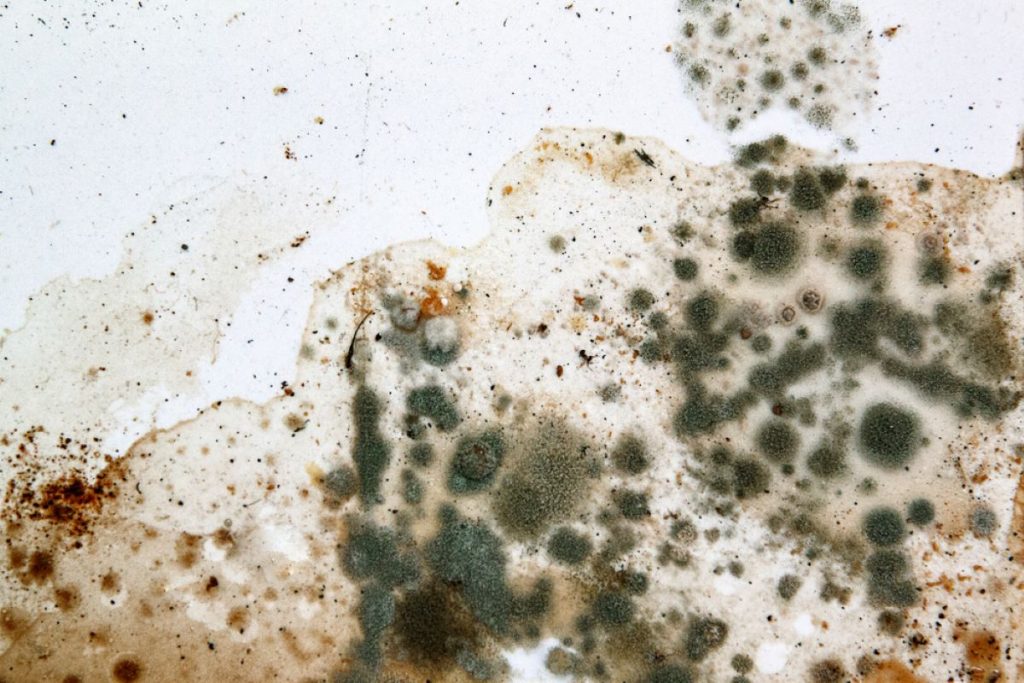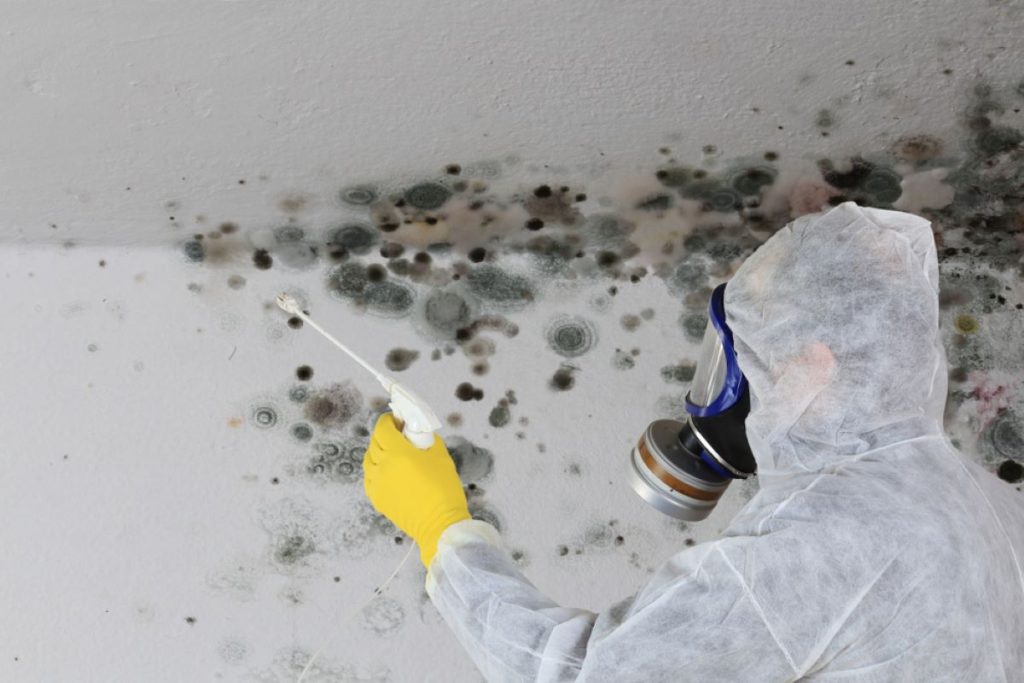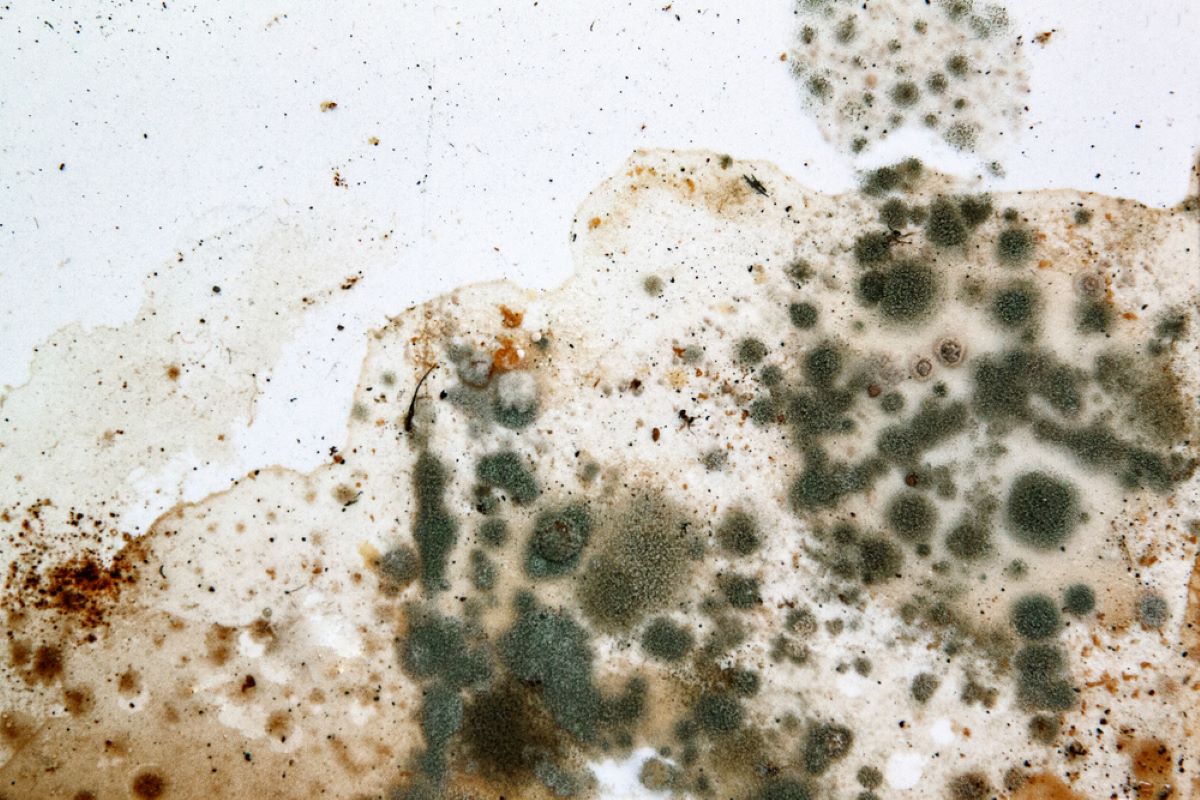Mold growth on walls is a common issue that many homeowners and renters face.
Mold isn’t just ugly; it can make health issues worse, especially for people with allergies, asthma, or weak immune systems.
Mold grows where it’s damp and warm, like on walls, and it spreads fast. Having mold at home can cause breathing problems, eye, nose, and throat irritation, and make existing health problems worse.
The importance of addressing mold growth cannot be overstated. Mold in your home harms its structure and air quality.
This affects everyone’s health. Act quickly and safely to stop mold from spreading.
Removing visible mold isn’t enough. Find and fix the causes, like leaks or high humidity.
I’ve dealt with this myself, and I promise, with the right method, getting rid of mold is not just doable, it’s important for a healthy home.
This article will show you how to clean mold off walls properly. We’ll talk about staying safe and stopping mold from coming back.

How To Identify Mold
Mold can look different. It might be black, red, green, or gray. It can be spots, fuzzy stuff, or slimy coatings. You might find it on walls, ceilings, or floors.
You might smell mold before you see it. It often smells musty or earthy. Look out for signs of moisture too. These could be water stains, peeling paint, or condensation on windows.
You can use mold test kits at home. But it’s best to get a professional inspection for a thorough check.
Several common types of mold found indoors include:
- Mucormycetes: You might see fuzzy white or light gray puffs. They get darker gray as they grow. They’re usually in soil or plants. Sometimes, they can grow indoors on rotting stuff or in air conditioner pipes.
- Alternaria: A mold that can cause allergies grows in wet places. You can recognize it by its soft, velvety look and brown strands. It can trigger asthma-type symptoms and upper respiratory disorders.
- Aspergillus: This mold has over 180 strains and can vary in color. Some strains are not harmful, but some can make sick people with weak immune systems very sick.
- Acremonium: You can find almost 100 kinds of this mold in damp spots, such as air conditioner pipes where water collects. Breathing in the spores of this mold called acremonium can lead to different symptoms, like eye irritation or pneumonia.
Preparing for Mold Removal
To protect yourself during the cleanup, it’s imperative to wear appropriate protective gear:
- Gloves: Wear long gloves that reach to the middle of the forearm. If you’re using a mild detergent, household rubber gloves may suffice. If you’re using powerful cleaning stuff like bleach, wear gloves that are tougher, like ones made from natural rubber.
- Eye Protection: Wear goggles without holes to stop mold bits from getting into your eyes and causing irritation. Goggles with holes can let in the bits through the openings, so they’re not good for cleaning up mold.
- Respirator: A respirator that can filter out mold spores is crucial for protecting your respiratory system. The EPA suggests using an N-95 respirator at a minimum. These are available at many hardware stores and online. These masks are made to fit snugly over your nose and mouth. They block 95% of tiny particles in the air, like mold spores.
Ventilation is another crucial aspect of preparing for mold removal. Good airflow stops mold spores from gathering in the air.
It also dries the place, making it less good for mold to grow. Here’s how to achieve effective ventilation:
- Open Windows: Before you start cleaning up, open windows to let in the fresh air and improve airflow in the room. This helps to dissipate mold spores and reduce the risk of inhaling them.
- Use Fans: Position fans to create a flow of air towards the open windows. This can help move mold spores outside. Be careful not to aim fans at the moldy spot. This might spread mold to other parts of the room or house.
Methods For Removing Mold
Here’s how to handle mold removal from small to large patches:
1. Small Mold Patches
For small areas of mold growth (less than about 10 square feet), you can often handle the cleanup yourself. Here’s a simple method:
- Cleaning Solution: Make a gentle soap mix with water. If the mold is a bit harder to remove, try a mix of equal parts white vinegar and water. If the surface isn’t porous, you can use a mix of 1 part bleach and 10 parts water. But make sure the room has good airflow and wear protective gear.
- Scrubbing: Scrub the mold off the wall using a brush with stiff bristles. Dip the brush in the cleaning solution before you start.. Be gentle to avoid damaging the paint or wall surface.
- Rinsing: Wipe the area clean with a damp cloth to remove any mold residue and cleaning solution.
- Drying: Allow the wall to dry completely. A fan or dehumidifier can speed up the drying process.
Remember, the key to preventing mold return is moisture control. Find and repair any moisture problems, like leaks or high humidity, to stop mold from returning.
2. Large Mold Patches
If there’s a lot of mold (more than 10 square feet), it’s harder to deal with. And there’s a bigger chance it will spread spores in your home. In these cases, containment and thorough cleaning are crucial:
- Containment: Seal off the affected area from the rest of the house with plastic sheeting and tape. This prevents mold spores from spreading during the cleaning process.
- HEPA Vacuum: Before you clean, use a vacuum with a HEPA filter to suck up lots of spores from the area.
- Cleaning Solution: Use the same cleaning stuff for small areas. You might need to clean a few times or try stronger solutions for tough mold.
- Professional Assessment: If there’s a lot of mold, it’s smart to get a professional to check it first. That way, you know what you’re dealing with before you start fixing it. They can provide specific advice on containment, removal, and preventing future growth.
3. Extensive Mold Growth
If lots of mold is in your home or if there’s dangerous black mold, you need pros to fix it.
Pros have the tools, chemicals, and safety gear to remove big mold problems safely. They can also fix walls, frames, and other parts hurt by mold.
They’ll also find why the mold grew, like leaks or too much moisture, to stop it from coming back.
This may involve improvements to ventilation, waterproofing, or the installation of dehumidifiers.
How To Remove Mold (Step-By-Step)
Here’s a clear, step-by-step guide to help you remove mold using safe and effective methods:
1. Preparation:
Before you start, protect yourself by wearing gloves, a mask (N-95 or higher), and goggles. Make sure the room has good airflow. Open windows and use fans to move air outside.
2. Materials Needed:
White vinegar or a bleach solution (1 part bleach to 10 parts water) should be used for non-porous surfaces. However, bleach doesn’t work well on porous surfaces. So, use vinegar without water instead.
- Spray bottle or a bucket.
- Stiff-bristle brush or sponge.
- Clean, damp cloth for rinsing.
- Disposable bags for contaminated materials.
3. Cleaning Process:
Apply the Cleaning Solution: If using vinegar, spray it directly onto the moldy area and let it sit for an hour.
When using bleach, make sure to cover the area well with the solution, but don’t soak the wall too much.
Scrub the Mold Away: Once the solution has worked, use a tough brush or sponge to gently scrub the mold off the wall.
Be thorough, but avoid damaging the wall surface.
Rinse the Area: Wipe the area with a clean, damp cloth to remove any mold residue and cleaning solution. This step is crucial for preventing mold spores from remaining on the surface.
Dry the Area Completely: Use clean towels or let the area air dry completely. A dehumidifier or fan can speed up the drying process and help prevent mold from returning.
Post-Cleaning: To stop mold spores from spreading, throw away any cloths, sponges, or brushes you used for cleaning. Seal them in a disposable bag before throwing them away.
Prevention: Once you clean up, find and repair any problems like leaks or high humidity that cause mold. This stops mold from coming back later on.

How To Prevent Mold Growth
Here’s how you can tackle this challenge effectively:
1. Control Indoor Humidity
The EPA recommends keeping indoor humidity levels between 30% and 50%.
High humidity levels provide the perfect environment for mold spores to thrive. You can control humidity by:
- Using dehumidifiers and air conditioners, especially during hot, humid months.
- Venting bathrooms, dryers, and other moisture-generating sources to the outside.
- Turn on exhaust fans in kitchens and bathrooms when making steam or after showering to remove moisture.
2. Improve Ventilation
Poor ventilation can trap moisture indoors and contribute to mold growth. Improve airflow in your home by:
- Opening windows and doors when weather permits to increase cross-ventilation.
- Using fans to circulate air within the home.
- Make sure vents and air filters are clean and unobstructed.
3. Fix Leaks Promptly
Check your home often for leaks from roofs, pipes, windows, or foundations. Fix them quickly to stop too much moisture. Molds need this moisture to grow.
4. Dry Wet Areas Immediately
Mold can begin to grow on damp surfaces within 24 to 48 hours. Addressing any wet areas immediately can prevent mold from taking hold. This includes:
- Drying up spills and leaks without delay.
- Removing wet carpets or furniture if they cannot be dried completely.
- Make sure clothing and shoes are dry before storing them.
5. Use Mold-Resistant Products
When you’re renovating or building, pick materials that resist mold. This is important, especially in places with lots of moisture, such as bathrooms, kitchens, and basements.
6. Maintain the Exterior of Your Home
Prevent water from entering your home by maintaining the exterior:
- Ensure that the ground slopes away from your home’s foundation to prevent water pooling.
- Keep gutters and downspouts clear and repair them if necessary.
- Check the roof for damaged shingles or leaks.
When to Call in the Professionals
Knowing when to ask mold experts for help can save you time and money. It also makes sure your health and home stay safe.
Here are some situations when seeking professional help is the best course of action:
1. Extensive Mold Growth
If the mold covers a large area (more than about 10 square feet), it’s wise to hire professionals. They can safely take away mold from big spaces in your home without spreading it, using tools, protective gear, and their know-how.
2. Mold is in HVAC Systems
Mold in your heating, air conditioning, and ventilation systems can move everywhere in your house.
It can make the air bad and cause health problems. Professionals can clean your HVAC systems to ensure mold spores are fully eradicated.
3. After Flooding
If your home got really wet, especially from flooding, it’s important to get it checked by experts who remove mold.
Floodwater usually has bad bacteria and mold. They can spread fast in these conditions and need special treatment.
4. Health Concerns
If you or someone at home feels sick because of mold, like having trouble breathing, allergies, or strange symptoms, it’s important to talk to experts.
They can identify and remove the mold, potentially alleviating these health issues.
5. Uncertain About the Extent of Mold
Mold can be hidden, but you might notice a musty smell or suspect mold if there’s been water damage.
Professionals can perform thorough inspections using advanced tools to detect hidden mold.
6. Recurring Mold
If mold keeps coming back after you clean it, there might be a bigger problem. You may need a professional to check and fix it.
The mold might be coming back because of hidden leaks or too much moisture. Experts can find and solve these issues.
7. Toxic Mold Presence
Some molds, like black mold, can make toxins that are really bad for you.
If you think you have toxic mold, you need professionals to get rid of it safely and make sure it’s safe to be around again.
Experts can help fix the mold problem and tell you how to stop it from happening again.
They’ll find out why there’s moisture making the mold grow and suggest ways to stop it from coming back. This way, your home stays healthy and free from mold.
Conclusion
To clean mold from walls, you can use different methods based on how bad it is.
For small patches, like in bathrooms, you can use simple things like water and vinegar or bleach.
Make sure to wear gloves, masks, and goggles, and keep the area well-ventilated while cleaning.
For bigger patches, you might need stronger cleaners or even professional help to remove the mold safely.
If you have a lot of mold, especially in places like air conditioning systems, it’s best to call experts.
They know how to deal with it safely and have the right tools and gear. They can also fix any moisture problems causing the mold.

Leave a Reply